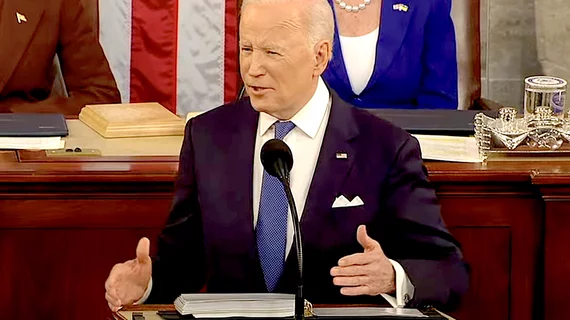Contrast shortage update: House Members urge President Biden to intervene
In a letter addressed to President Biden, 30 Members of Congress urged the President to use his authority to intervene in the ongoing shortage of iodinated contrast media.
“With the lack of intravenous contrast fluids and the potential for further depletion, many physicians and patients could continue facing delays in the detection of diseases like cancer. We urge your Administration to immediately deploy a whole of government response and work directly with stakeholders to resolve this shortage,” the letter, shared on June 13, reads.
The shortage, which stems from COVID lockdowns in Shanghai that temporarily sidelined production of GE’s Iohexol and Iodixanol intravenous contrast media products, continues to impact medical practices in the United States and beyond. Since April, thousands of procedures and exams have been either delayed or canceled due to the shortage, and although the manufacturing facility has since resumed operations, GE and the FDA have both indicated that it could still take months for the supply to stabilize.
The 30 GOP members who signed the letter were particularly critical of the fact that the shortage is a result of COVID lockdowns in China, stating that this crisis brings to light “the urgent need to establish an outbound investment review process to ensure that critical capabilities are not being offshored, especially to our adversaries, without visibility by the U.S. government.”
By this point, the contrast shortage has made its way into multiple government discussions outside of its recent debut on the President’s desk. The American Medical Association has voiced support for a recent resolution urging Congress to address shortages of other everyday drugs, and at their annual meeting held earlier in June it was decided by providers from all different walks that contrast agent language should be included in the text.
Arl Van Moore, MD, delegate to the AMA House of Delegates and former ACR president, discussed these policy decisions and the efforts to petition Congress and other entities, describing it as a group effort that spans across multiple specialties:
“We have our frustrations within our own specialty, and you hear about issues others have that are unique to their specialty,” Van Moore said. “What you find is that there are common threads, and we can put something together in terms of a whole cloth and address the problem in a more unified way.”
View the full GOP letter here.
View the interview with Arl Van Moore at the AMA Conference here.
More on the contrast media shortage:
VIDEO: American College of Radiology working with FDA to mitigate contrast shortage
Gadolinium can be used as substitute for iodine contrast in some interventional imaging procedures
Addressing contrast media shortage in the short, mid and long term
Preserving contrast media supplies: 7 ACR recommendations

